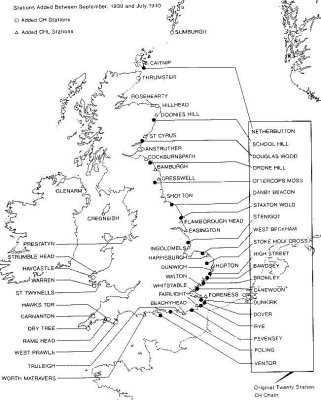The Chain Home radar system
BIBLIOGRAPHY
- 1 Journal of the lEE, 93, Pt. IIIA, (Radiolocation)
1946.
- 2 TAYLOR, D., 'Introduction to Radar and Radar Techniques', Newnes, London, 1966.
- 3 WOOD, D. and DEMPSTER, N., 'The Narrow Margin', Arrow Books, 1961.
- 4 CLARK, R. W., 'Tizard', Methuen & Co. Ltd., 1965.
- 2 TAYLOR, D., 'Introduction to Radar and Radar Techniques', Newnes, London, 1966.
APPENDIX I. List of 'East Coast Type' CH Stations
|
1. Ventnor Isle of Wight |
The Radar Chain during the Battle of
Britain |
APPENDIX 2. Extract from Siting Specification for CH - 'RDF' Stations (circa 1936)
A site well back from the coast, with a smooth slope between it and the sea, gave good height-finding and good range-finding - there was a rule by which one knew how far inland it was worth going to get height above sea level. But irregularities of ground were inevitable and these distorted the height-finding properties of the equipment and gave 'permanent echoes' similar to those produced from large aircraft. The chosen sites had also to be accessible to heavy engineering works; to have soil suitable for carrying 360 foot steel masts - they had to be convenient for electrical supplies, secure against sea bombardment, inconspicuous from the air and it was furthermore essential that they should not 'gravely interfere with grouse shooting....'.
The above article was reproduced from "The GEC Journal of Research", Vol. 3 No.2 1985 with the kind permission of the Editor. The copyright of the material remains with the owner.
The opening of the Russian Front had diverted much of Germany's bomber effort and, except for the "Baedeker raids" in 1942 and attempts at reprisals against R.A.F. and USAAF raids on German cities, the Luftwaffe never again attacked on the scale of the Battle of Britain or the Blitz. At the same time new technology, the expansion of the radar system overseas and the requirement for skilled personnel for airborne radar had put the radar manpower situation under strain. In order to ease this strain and release the skilled personnel it was decided in November 1943 that the Chain Home system would be placed into four categories;
1. Some stations would continue full operation,
2. Some stations would operate reduced watches and track handling,
3. Some
stations would be placed on care and maintenance and,
4. Some stations would
be dismantled.
And so began the run down of the worlds first air defence radar system. Chain Home continued in operational use into the mid 1950's when it finally relinquished its role to the new generation of air defence search radars.




